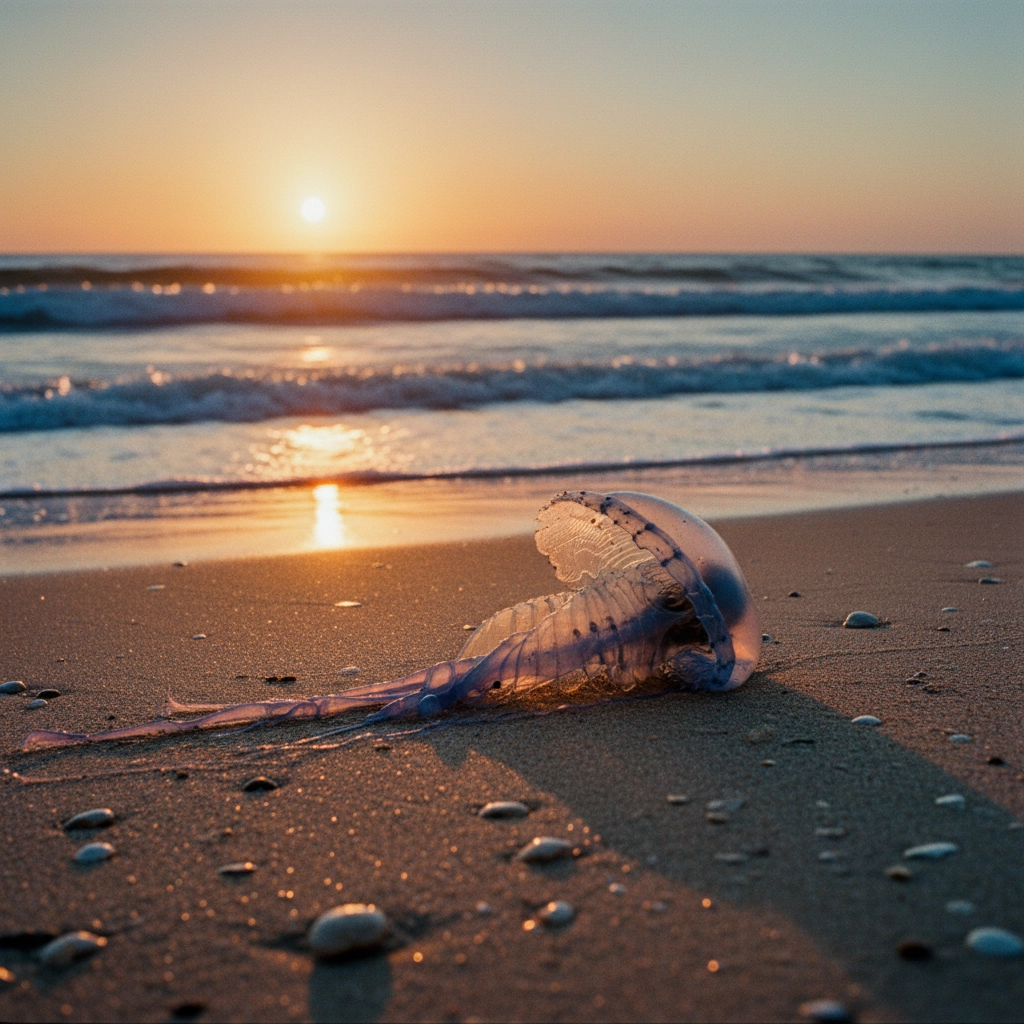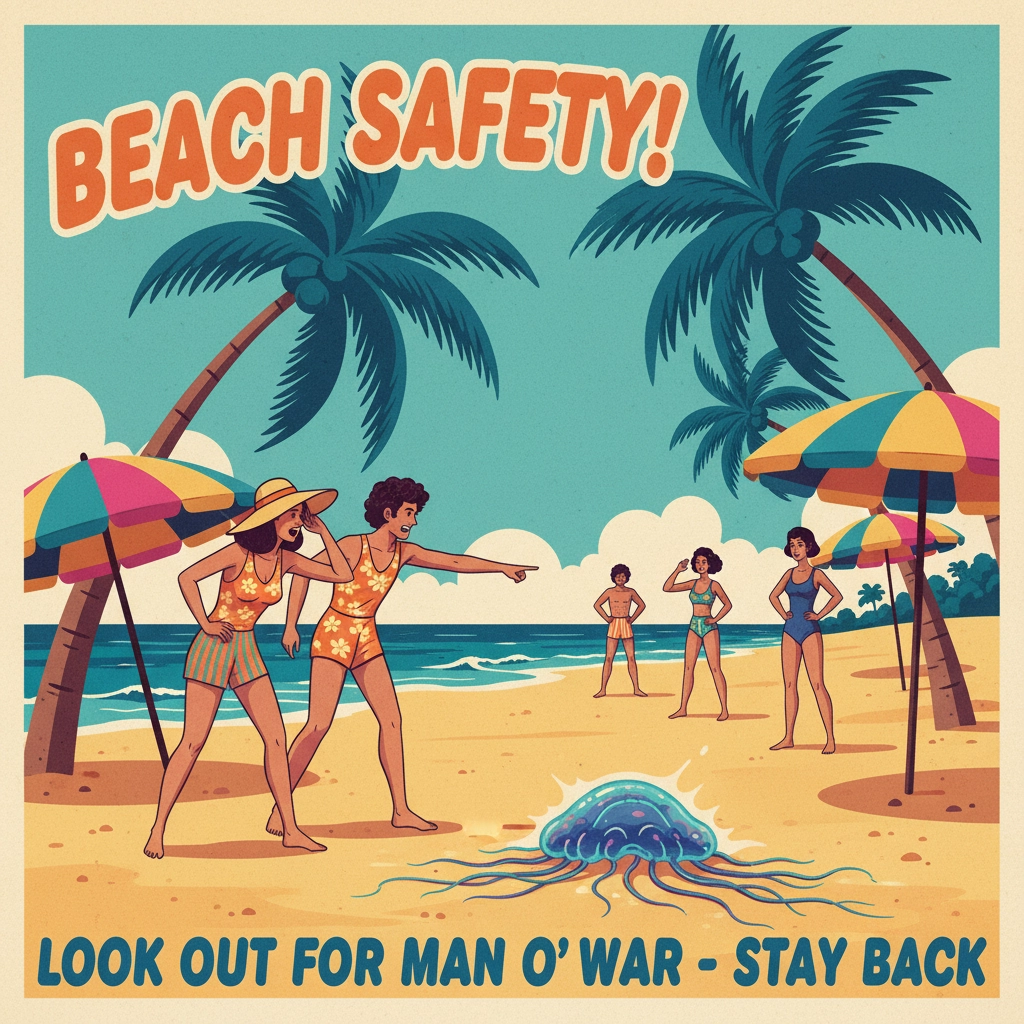
Portuguese Man O' War on the Beach: What To Do (And What Not To Do)
Share
You're cruising down the Gulf Coast, ready for another epic beach day, when you spot something that looks like a deflated balloon with ribbons trailing behind it. Hold up. That's no party decoration washed ashore: that's a Portuguese Man O' War, and it's definitely not your friend.
These translucent, jellyfish-looking creatures show up on our Gulf Coast beaches more often than we'd like. They drift in with the currents and get pushed ashore by onshore winds, especially after storms. For beach lovers, surfers, and anyone who spends time by the water, knowing how to handle these guys can save you from a seriously painful day.

What Exactly Is a Portuguese Man O' War?
First things first: this isn't actually a jellyfish. The Portuguese Man O' War is a siphonophore, which sounds fancy but basically means it's a colony of tiny organisms working together. Picture a blue or purple gas-filled bladder that floats on the surface like a sail, with tentacles that can stretch over 160 feet underwater.
Those tentacles pack venom-filled cells called nematocysts that fire when touched. Even a light brush can trigger thousands of these microscopic harpoons to inject venom into your skin. The pain hits immediately and can last for hours.
On Gulf Coast beaches, they're most common during warmer months when offshore winds push them toward shore. After storms or when the wind shifts, you might see dozens scattered across the sand like blue plastic bags.
The Golden Rule: Leave It Alone
Here's the straight answer to the big question: should you put it back in the water or leave it alone? Always leave it alone. Don't touch it, don't move it, and definitely don't try to "rescue" it by putting it back in the ocean.
Even when a Portuguese Man O' War looks dead, dried up, or completely deflated on the sand, those tentacles stay dangerous for hours. Sometimes days. The venom cells don't need the creature to be alive to fire: they're like tiny loaded weapons just waiting for contact.
Moving them back to the water doesn't help them anyway. If they've washed ashore, they're likely already damaged or dying. Plus, you'd be putting other swimmers and surfers at risk by returning an active stinger to the water.

What to Do When You Spot One
Keep Your Distance
Give these guys a wide berth. Those tentacles might be buried in the sand or stretched out further than you can see. A good rule of thumb is to stay at least 30 feet away if you can.
Alert Others
Warn fellow beachgoers, especially families with kids who might not recognize the danger. Point it out to lifeguards or beach patrol if they're around. Most Gulf Coast beaches have protocols for handling marine hazards.
Check for More
Where there's one, there are often others. Portuguese Man O' Wars travel in groups, so scan the waterline and surf zone before jumping in. Look for those distinctive blue sails bobbing in the waves or scattered on the sand.
Document and Report
Take a photo from a safe distance and report it to local beach authorities. Many coastal areas track these sightings to issue warnings to other beachgoers.
If You Get Stung
Despite your best efforts, sometimes contact happens. Maybe you stepped on buried tentacles or brushed against one while surfing. Here's what to do:
Get Out of the Water Fast
Exit immediately. The pain will be intense: like getting hit with a hot wire: but don't panic. Get to shore and find help.
Don't Touch or Rub
Your first instinct might be to rub the area, but resist. This can cause more venom cells to fire and make the sting worse. Don't try to remove visible tentacle pieces with your hands.

Rinse with Hot Water
Use hot water (as hot as you can stand) to rinse the affected area. The heat helps break down the venom proteins. If hot water isn't available, use salt water. Never use fresh water, ice, or: despite what you might have heard: urine. These can actually trigger more venom release.
Remove Tentacle Pieces Safely
If you can see tentacle fragments on your skin, use tweezers or a credit card to gently scrape them off. Don't use your bare hands.
Get Medical Help
Head to the nearest lifeguard station, beach first aid center, or urgent care. Portuguese Man O' War stings can cause allergic reactions, and some people need professional medical treatment. If you experience difficulty breathing, chest pain, or severe swelling, call 911 immediately.
Prevention Is Your Best Defense
Check Beach Conditions
Before you hit the waves, check local beach reports and talk to lifeguards. Many Gulf Coast beaches post warnings when Portuguese Man O' Wars are spotted offshore.
Wear Protection
If you're surfing or swimming in areas known for Man O' War activity, consider wearing a wetsuit or rash guard. The extra layer provides some protection against stings. Full-body exposure suits offer the best protection if you're diving or spending extended time in the water.
Time Your Sessions
Portuguese Man O' Wars are more likely to wash ashore during certain wind conditions. Offshore winds tend to push them away from the coast, while onshore winds bring them in. Check wind forecasts before planning your beach day.
Stay Alert in the Water
While surfing or swimming, keep your eyes open for those blue sails floating on the surface. They're usually visible from a distance, especially on calm days. If you spot one, alert others and give it plenty of space.

Respecting Coastal Wildlife
Portuguese Man O' Wars might be dangerous, but they're part of the Gulf Coast ecosystem. They feed on small fish and provide food for sea turtles and ocean sunfish. Rather than seeing them as beach villains, think of them as reminders that we're visiting their territory.
When you encounter marine life on the beach: whether it's a Man O' War, jellyfish, or sea turtle: the best approach is always observation from a distance. Take photos, share the experience, but let nature be.
Know Before You Go
The Gulf Coast delivers incredible surf and unforgettable beach days, but it pays to stay informed about what's in the water. Portuguese Man O' Wars are just one of the marine creatures you might encounter. The more you know, the safer and more enjoyable your time on the water becomes.
Check with local surf shops, beach patrol, or marine science centers for current conditions. Many post regular updates about water quality, marine life sightings, and surf conditions. Some areas even have apps that alert users to Portuguese Man O' War activity.
For surfers and beach lovers who spend serious time in Gulf Coast waters, building relationships with lifeguards and local marine biologists can provide valuable insights about seasonal patterns and safety tips.
Your beach days should be about catching waves, soaking up sun, and living that coastal lifestyle. A little knowledge about Portuguese Man O' Wars keeps those good times rolling safely. Remember: when in doubt, stay out, and always respect the power of the ocean and its inhabitants.
Watch your step, respect the wildlife, and keep making memories on the Gulf Coast. The beach will always be here, and with the right awareness, you can enjoy it safely for years to come.
